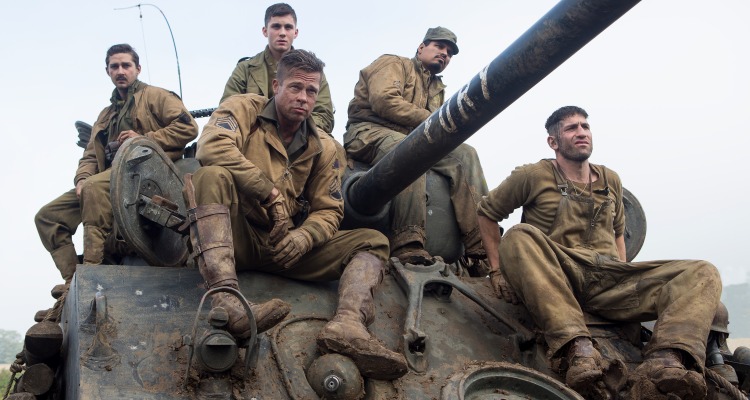 (4 / 5)
(4 / 5)
Is there anything quite so cinematic as war? The mud, the blood, the bullets, the explosions; the scale, the intimacy; the stakes, both large and small.
An elegantly uniformed rider on a pale horse makes his way through a graveyard of shattered military hardware. As the camera follows him, he is set upon, roughly unhorsed, and brutally stabbed to death. The message is instantly clear: this isn’t some noble, abstract Death – dying cleanly, heroically, for some grand cause; this is a world of kill or be killed, where you do whatever you can to survive.
Fury focuses on the micro – a five-man Sherman tank unit, led by Sgt. Don “Wardaddy” Collier (Brad Pitt), in the dying days of World War 2 – and, in doing so, conjures up a parable on man’s inhumanity to man. Most of all, it’s a visceral film – literally so: rookie assistant driver Norman (Logan Lerman) is forced to wipe his predecessor’s face off the inside of the tank’s bulkhead.
As a war-set actioner, Fury apes Saving Private Ryan; the team making their way through enemy territory, in close quarters and constantly under pressure. While essentially a submarine movie on dry land – the tank, “Fury”, is a hotbox of frustrations and camaraderie – every whizzing shell reminds us of how insubstantial these lumbering death machines can be.
The inexperienced Norman is, like us, unequipped for the realities of war. Unlike the four men he’s cooped up with – scar-faced, pragmatic Wardaddy; teary-eyed, Bible-thumping Swan (Shia LaBeouf); the quietly traumatized Gordo (Michael Peña); and the s**t-stirring Travis (Jon Bernthal) – he’s a good man in a time and place that doesn’t allow for mercy or hesitation.
Through a series of memorable set-pieces – an assault on a sniper’s nest in a German town, an almost balletic face-off against a Tiger (filmed using the last fully operational one left in existence) – Fury proceeds to beat the s**t out of its audience surrogate, wearing down his reserve, thickening his skin, in preparation for the 360°-of-chaos finale. War may be hell, but it’s one where morality does not apply.
But, amidst all the brutal, jolting violence, where Fury succeeds best is in showing us the people who occupy this blasted landscape. Civilians may be hanging from lampposts, soldiers may be mulched beneath tank treads, but Wardaddy still tries to generate some sense of normalcy; playing at tea while the bombs are falling, much to the grievance of his makeshift family.
Each of the tank crew gets their individual moment, but Fury is about the sum total, how they come together. With uniformly committed performances – LaBeouf particularly impresses, given his prior resume – the film never overplays its “tank as home” subtext (it’s not that twee), but focuses on the contradiction of what the team, not entirely jokingly, call “the best job” ever.
Harrowing and largely uncompromising, Fury doesn’t offer hope, per se; you can’t go home again, but maybe you can find something to live for out there in no-man’s land.
